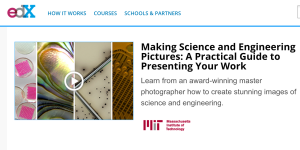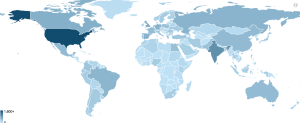We are launched. Making Science and Engineering Pictures, an MITx MOOC, is now officially underway. What a contrast to consider the differences between memories of “first day of class” versus what we’re experiencing with this online course. Trudging my way to school with new Pee Chee folders and three ring binders, sharpened pencils, and a pristine lunchbox versus our course team, hunched over our laptops, connected via Skype at 9:00 AM EDT, watching as the first “introduce yourself” posts streamed in.
On day one (June 15, 2015), the course enrollment stood at 6,441 students. Naturally, we know that number will dwindle – it’s a low bar to register for an edX course, all you need is an email address. If the final number of actively participating students dwindles to 500, I’ll be happy. That’s 450 more than we could have reasonably managed in a face-to-face course. 450 more people who will, if we’ve done it right, learn how to make more effective and compelling images of their work.
0.111x is an online digital photography course, conceived of and taught by Felice Frankel. Felice is talented science photographer who, over the years, has carved out an intriguing niche – working closely with scientists and engineers to help them see their work in a new way. Felice examines the products and objects of a scientists’ work and asks thoughtful, yet naïve, questions (Is that element really necessary? What’s the most important point that you need to convey? Why is this gray? I am confused by this, can you tell me what’s going on here?) and then assembles their petri dishes, batteries, sensors, microreactors, and fuel cells in innovative, clever ways. The results are often novel, wholly original, and always interesting.
In this course, Felice has attempted to capture the way she works; the themes and truths behind her approach to visualizing science. She imparts her acquired wisdom in a series of conceptual videos, spanning six week of topics (flatbed scanners, camera basics, lighting, mobile devices/video, presenting your work, and a final week of case study examination). Weekly assignments, designed so that the student photographers discover the week’s principles for themselves, complement the instructional videos.
Starting in week 1, students will upload their photographs to an online visual collaboration platform called VoiceThread (VT). As students log into VT, from the edX course environment, they will be automatically sorted into groups of 30 (I can’t help but think of the sorting hat in Harry Potter). There, in these small online groups, our students will post, share, discuss, and critique their images. This course is a purpose-driven, as opposed to a content-driven, learning environment. What they learn will come as a side effect of their actions, the images they create and discuss with each other and with us. Our instructional material [here’s a sample instructional video from the course on how to use a flatbed scanner to create images of 3D objects] is all designed to support the students’ efforts to master the photographer’s tools (light, aperture, shutter speed, background, and pattern), to create their best possible images to explain what they do.
And what do they do? Who are these 6, 441 students? Judging by those who’ve so far logged into the discussion forum they are physicists, filmmakers, graduate students, park rangers, molecular biologists, amateur photographers, science communicators, shutterbugs, high and middle school teachers, artists, and neuroscientists. They are from Spain, Brazil, India, Uruguay, Ireland, Canada, Ecuador, Austria, Norway, Italy, China, Scotland, Germany, Puerto Rico, Pakistan, and all over the U.S. Among their reasons for taking the course…. They want to improve the photos they take for their students, for their research group, for themselves, or for the general public. One thing that’s interesting about reading the intended learning goals of a group of MOOC students is that everyone is here because they want to be here. This is not a requirement for anyone – they are pursuing something that interests them, something that they want to learn. Students in this course will document what they’ve learned with the images they create and the VoiceThread conversations they conduct around those images. By sharing and critiquing the images they produce (shared objects of reflection), we will all learn as much from our failures as we do from successes. We’ve provided sample VTs and rubrics to guide their work, but ultimately, the students will devise their own quality standards for evaluating their work and the work of their peers. Part of our mission is to encourage the creation and adoption of critical standards.
We all know that the best, most effective learning comes when students pursue something that interests them, create their own objects of learning, and are supported by peers who are engaged along with them. We like to think that’s what we’ve created with 0.111x. Let’s find out.




Let the learning– for students and educators alike– begin! Learning out of desire on both ends of the learning experience.